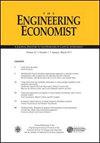编辑来信
IF 1.2
4区 经济学
Q4 BUSINESS
引用次数: 0
摘要
将机器学习和优化等工程方法应用于财务分析可以产生强大的结果,正如本期发表的前两篇文章所述。我们还提供了一个案例分析,展示了一个独特行业的主要资本投资分析。我要感谢为同行评审过程做出贡献的审稿人,以及领域编辑David Enke、Roy Kwon和Karen Bursic,感谢他们对本期的贡献。本期以一篇题为“用机器学习方法预测股票指数的盘中趋势”的文章开始,作者是Tang、Tang和Yu。作者预测了上海证券50指数的价格走势,并提出了三种基于机器学习方法的交易策略。具体而言,构建了决策树分析、极端梯度增强、随机森林、支持向量机(SVM)和长短期记忆,并在不同时间频率下进行了比较。结果表明,在相同时间频率下,支持向量机的表现优于其他支持向量机,总体而言,本文的研究结果进一步丰富了量化交易策略。在Langaroudi, Khosravi, Davoodi和Movahedifar的“自筹资金可分阶段和不可分阶段项目组合选择和调度问题的现金持有管理”中,提出了一种新的管理自筹资金可分阶段项目组合选择和调度问题的现金储备水平的数学模型。通过一个例子说明了混合整数规划方法的适用性和性能。Amir、Efendy和Hidayat共同撰写了《开发小型盐业工厂的经济可行性——以特鲁诺霍约·马杜拉大学为例》。他们的案例研究为特鲁诺霍约·马杜拉大学小型盐厂的发展提供了经济分析。该项目展示了净现值、内部回报率、效益成本比和投资回报率,具有经济吸引力,是减轻印尼对盐进口依赖的可行选择。《工程经济学家》杂志发表文章、案例研究、调查、书籍和软件评论,它们代表了涉及资本投资问题的原始研究、当前实践和教学。如有任何问题或疑问,请通过hln@uark.edu与我联系。本文章由计算机程序翻译,如有差异,请以英文原文为准。
Letter from the editor
Applying engineering methods such as machine learning and optimization to financial analyses can lead to powerful outcomes as presented in the first two articles published in this issue. We also feature a case analysis demonstrating major capital investment analysis within a unique industry. I would like to thank the reviewers who contributed to the peer-review process as well as area editors David Enke, Roy Kwon, and Karen Bursic for their contributions to this issue. The issue begins with an article entitled “Intraday Trend Prediction of Stock Indices with Machine Learning Approaches” by Tang, Tang, and Yu. The authors predict price movements of Shanghai Securities 50 Index and propose three kinds of trading strategies based on machine learning approaches. Specifically, decision tree analysis, eXtreme Gradient Boosting, random forest, support vector machines (SVM), and long short-term memory are constructed and compared at different time frequencies. The results show that SVM outperforms others at the same time frequency, and overall, the findings of this article further enrich quantitative trading strategies. In “Cash Holding Management for Self-Financing Phase-able and Non-Phase-able Project Portfolio Selection and Scheduling Problems” by Langaroudi, Khosravi, Davoodi, and Movahedifar, a novel mathematical model for managing the level of cash reserves for the self-financing phase-able project portfolio selection and scheduling problem is presented. An example demonstrating their mixed-integer programming approach illustrates the applicability and performance of their model. Amir, Efendy, and Hidayat coauthored “Economic Feasibility of Developing a Mini-Salt Industry Plant A Case Study of the University of Trunojoyo Madura.” Their case study provides an economic analysis of the development of a mini-salt industry plant at the University of Trunojoyo Madura. Demonstrating net present value, internal rate of return, benefit-cost ratio, and return on investment, the project is found to be economically attractive and a feasible option for mitigating Indonesia’ salt-import dependency. The Engineering Economist journal publishes articles, case studies, surveys, and book and software reviews that represent original research, current practice, and teaching involving problems of capital investment. For questions or inquiries, please contact me at hln@uark.edu.
求助全文
通过发布文献求助,成功后即可免费获取论文全文。
去求助
来源期刊

Engineering Economist
ENGINEERING, INDUSTRIAL-OPERATIONS RESEARCH & MANAGEMENT SCIENCE
CiteScore
2.00
自引率
0.00%
发文量
14
审稿时长
>12 weeks
期刊介绍:
The Engineering Economist is a refereed journal published jointly by the Engineering Economy Division of the American Society of Engineering Education (ASEE) and the Institute of Industrial and Systems Engineers (IISE). The journal publishes articles, case studies, surveys, and book and software reviews that represent original research, current practice, and teaching involving problems of capital investment.
The journal seeks submissions in a number of areas, including, but not limited to: capital investment analysis, financial risk management, cost estimation and accounting, cost of capital, design economics, economic decision analysis, engineering economy education, research and development, and the analysis of public policy when it is relevant to the economic investment decisions made by engineers and technology managers.
 求助内容:
求助内容: 应助结果提醒方式:
应助结果提醒方式:


